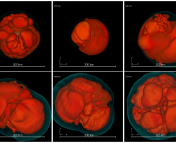Title: On the Origin of Pulsar and Magnetar Magnetic Fields
Authors: Christopher J. White, Adam Burrows, Matthew S. B. Coleman, David Vartanyan
First Author’s Institution: Department of Astrophysical Sciences, Princeton University, Princeton, NJ, 08544, USA
Status: Submitted to ApJ [open access on arXiv]
Magnetic fields at the surface of a neutron star can reach up to one-quadrillion times the strength of those on Earth — that’s a factor of one followed by fifteen zeros. If you were to step foot on a neutron star, the scrambling of your credit card data would be the least of your worries. At these magnetic field strengths, the supposed emptiness of space starts to refract light and light itself splits into matter and antimatter. If a frog starts levitating in fields one-hundred-thousand times stronger than the Earth’s, who knows what would happen to a frog on a neutron star!
So, how did these magnetic fields get so strong?
Cooking up a neutron star core
First, let’s step back a bit and review how neutron stars form. In short, neutron stars are the remnants of the deaths of old, massive stars. When a heavy main-sequence star (typically between 8 and 25 times the mass of our Sun) runs out of fuel for fusion in its core, the core becomes “degenerate,” meaning that peculiar quantum mechanical effects prevent the core from collapsing. However, as more matter piles onto the degenerate core and the core exceeds the Chandrasekhar mass, the core contracts and heats up to billions of kelvin, forcing electrons and protons to combine into neutrons, releasing a deluge of high-energy neutrinos in the process. This “proto-neutron star” (PNS) core continues to contract until it reaches the density of an atomic nucleus. Meanwhile, the infalling outer regions of the original star “bounce” off the degenerate core and are expelled by the outgoing neutrinos, resulting in the violent explosion of the star via “core-collapse supernova.” When the dust settles, all that’s left is the neutron star core.
Well, then, how does this core-collapse process relate to the extreme magnetic fields possessed by neutron stars? One explanation is that the number of magnetic field lines threading the surface of the contracting proto-neutron star must stay fixed, so, as the PNS shrinks, the field lines bunch together and amplify the total field strength. However, this model fails to capture the dichotomy between radio pulsars — rapidly rotating neutron stars with relatively lower magnetic field strengths (typically between 1011 and 1013 times as strong as the Earth’s field) — and magnetars — slowly rotating neutron stars with exceedingly powerful magnetic fields (reaching up to 1015 times as strong as the Earth’s). With this dichotomy in mind, the authors of today’s paper propose a new avenue for the growth of neutron star fields: convective dynamos in collapsing PNS cores.
Stirring up magnetic fields

Dynamos are responsible for generating and maintaining the magnetic fields of a wide array of astronomical objects, from young protostars and old, dim M dwarfs to the gas giants of the outer Solar System to the Earth itself (see Figure 1). If an astrophysical body is filled with electrically conducting fluid that’s continually undergoing convection (like the liquid iron in the Earth’s outer core), the rotation of the body will cause these convecting electrical currents to twist into elongated coils, thus producing large-scale magnetic fields — this is the fundamental mechanism of dynamo action. We can quantify the strength of a convective dynamo via the Rossby number, the ratio of the speed of fluid convection to the speed of the body’s rotation; a slowly rotating body containing vigorously convecting fluid will have a high Rossby number, while a fast-rotating body with weaker convection will have a low Rossby number. A natural dichotomy in magnetic field strength arises from a threshold value for the Rossby number: dynamos with Rossby numbers below this threshold tend to produce stronger dipolar fields (like the Earth’s) that scale with the strength of convection, while dynamos with Rossby numbers above the threshold tend to produce weaker fields with multiple poles. Since proto-neutron stars are expected to undergo convection during core-collapse, dynamo action and this Rossby number dichotomy could explain the split between pulsars and magnetars.
Today’s authors thus turn to simulations of PNS formation in core-collapse supernovae to test this hypothesis. In a suite of 12 supernova simulations with non-rotating progenitor stars ranging from 9 solar masses to 25 solar masses (plus one simulation featuring a rotating 9 M☉ progenitor), the authors look at the convective power and the geometry of the fluid flow in the interiors of the developing PNSs; from these observations, the authors can infer the magnetic field strengths of the resulting neutron stars. Figure 2 shows the convective power as a function of radius for each of the simulations without rotation, demonstrating that convection becomes stronger with larger progenitor mass. Meanwhile, Figure 3 shows a comparison of the flow geometry between a simulation with a rotating progenitor vs. one without rotation, demonstrating the relative complexity of the flow in a rotating PNS. The fact that the interiors of rotating proto-neutron stars are capable of sustaining vigorous convection and complex fluid flows implies that dynamos in PNSs should be able to generate strong magnetic fields.


Completing the recipe
The authors conclude that convection in proto-neutron stars could play a vital role in setting the properties of newborn neutron stars. If a PNS rotates sufficiently quickly, then dynamo action will endow it with a strong dipolar magnetic field that will naturally reduce the star’s rotation speed over short time scales, yielding a slowly rotating, highly magnetized neutron star — in other words, a magnetar. On the other hand, a relatively slower-rotating PNS will develop weaker magnetic fields and will thus retain its nascent rotational velocity over a longer period of time — thus explaining the formation of pulsars.
While the simulations analyzed by the authors capture the fluid dynamics and neutrino physics of core-collapse supernovae in remarkable detail, they are missing one important ingredient: magnetic fields! Incorporating magnetic fields into these highly sophisticated simulations will be computationally challenging, but well worth-it: with fully realistic 3D simulations of core-collapse supernovae, we’ll finally be able to complete the recipe for turning massive stars into compact, magnetized neutron stars.
Astrobite edited by: Suchitra Narayanan
Featured image credit: Figure 1 in today’s paper.




